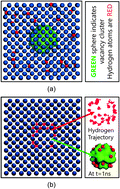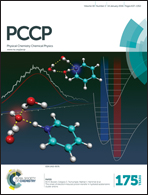Interactions of hydrogen with the iron and iron carbide interfaces: a ReaxFF molecular dynamics study†
Abstract
Hydrogen embrittlement (HE) is a well-known material phenomenon that causes significant loss in the mechanical strength of structural iron and often leads to catastrophic failures. In order to provide a detailed atomistic description of HE we have used a reactive bond order potential to adequately describe the diffusion of hydrogen as well as its chemical interaction with other hydrogen atoms, defects, and the host metal. The currently published ReaxFF force field for Fe/C/H systems was originally developed to describe Fischer–Tropsch (FT) catalysis [C. Zou, A. C. T. van Duin and D. C. Sorescu, Top. Catal., 2012, 55, 391–401], and especially had been trained for surface formation energies, binding energies of small hydrocarbon radicals on different surfaces of iron and the barrier heights of surface reactions. We merged this force field with the latest ReaxFF carbon parameters [S. Goverapet Srinivasan, A. C. T. van Duin and P. Ganesh, J. Phys. Chem. A, 2015, 119, 1089–5639] and used the same training data set to refit the Fe/C interaction parameters. The present work is focused on evaluating the applicability of this reactive force field to describe material characteristics and study the role of defects and impurities in the bulk and at the precipitator interfaces. We study the interactions of hydrogen with pure and defective α-iron (ferrite), Fe3C (cementite), and ferrite–cementite interfaces with a vacancy cluster. We also investigate the growth of nanovoids in α-iron using a grand canonical Monte Carlo (GCMC) scheme. The calculated hydrogen diffusion coefficients for both ferrite and cementite phases predict a decrease in the work of separation with increasing hydrogen concentration at the ferrite–cementite interface, suggesting a hydrogen-induced decohesion behavior. Hydrogen accumulation at the interface was observed during molecular dynamics (MD) simulations, which is consistent with experimental findings. These results demonstrate the ability of the ReaxFF potential to elucidate various aspects of hydrogen embrittlement in α-iron and hydrogen interactions at a more complex metal/metal carbide interface.


 Please wait while we load your content...
Please wait while we load your content...